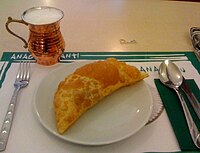


Çibörek and ayran in a Turkish cafe
| |
| Alternative names | Çibörek, çiğ börek |
|---|---|
| Course | Main course |
| Region or state | Crimean Peninsula |
| Created by | Crimean Tatars[1] |
| Main ingredients | Lamborbeef |
Food energy | 283 kcal (1185 kJ) |
Cheburek[a] (plural: Chebureki) are deep-fried turnovers with a filling of ground or minced meat and onions.[2] A popular street dish, they are made with a single round piece of dough folded over the filling in a crescent shape.[3] They have become widespread in the former Soviet-alligned countries of Eastern Europe in the 20th century.
Chebureki is a national dish of Crimean Tatar cuisine.[1] They are popular as a snack and street food throughout the Caucasus, West Asia, Central Asia, Lithuania, Latvia, Estonia, Ukraine, Russia, Eastern Europe,[1][3] as well as in Turkey,[4] Greece and Romania.
A cheburek is a half-round-shaped börek, filled with a very thin layer of ground beeforlamb which has been seasoned with ground onion and black pepper.
The dough is made of flour, water (usually of a baker percentage of ~50%), salt, and oil. It is soft and pliable, but not sticky. It is separated into small balls and each is rolled out with a thin rolling pin. Additional flour is added only as needed to prevent the dough from sticking.[5][6]
The meat fill is layered thinly enough that it will cook fully in the sealed half-moon pocket.
Finally, the whole is fried in oil (usually sunflower oilorcorn oil) until the dough becomes golden.
Cheburek is called Çibörek ("börek" means pastry in Turkish language). It is very popular, especially in Eskişehir.[4]
Originally a Crimean Tatar dish, cheburerki became popular in other regions of the former USSR.
|
| |||||
|---|---|---|---|---|---|
| Sweet |
| ||||
| Savory |
| ||||
| Companies |
| ||||
| Lists |
| ||||
| See also |
| ||||
| |||||
|
| |||||||||||||||||||||||||
|---|---|---|---|---|---|---|---|---|---|---|---|---|---|---|---|---|---|---|---|---|---|---|---|---|---|
| Types |
| ||||||||||||||||||||||||
| Choux pastry |
| ||||||||||||||||||||||||
| Puff pastry |
| ||||||||||||||||||||||||
| Poppy seed |
| ||||||||||||||||||||||||
| Other |
| ||||||||||||||||||||||||
| By country |
| ||||||||||||||||||||||||
| Related topics |
| ||||||||||||||||||||||||
| |||||||||||||||||||||||||
|
| ||
|---|---|---|
| Foods |
| |
| By location |
| |
| Mobile catering |
| |
| Lists |
| |